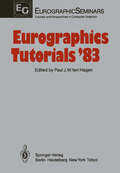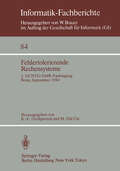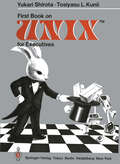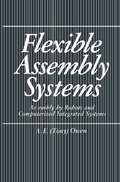- Table View
- List View
Discrete Systems: Analysis, Control and Optimization (Communications and Control Engineering)
by Magdi S Mahmoud M.G. SinghMore and more digital devices are being used for informa tion processing and control purposes in a variety of systems applications, including industrial processes, power networks, biological systems and communication networks. This trend has been helped by the advent of microprocessors and the consequent availability of cheap distributed computing power. For those applications, where digital devices are used, it is reasonable to model the system in discrete-time. In addition there are other application areas, e.g. econometric systems, business systems, certain command and control systems, environmental systems, where the underlying models are in discrete-time and here discrete-time approaches to analysis and control are the most appropriate. In order to deal with these two situations, there has been a lot of interest in developing techLiques which allow us to do analysis, design and control of discrete-time systems. This book provides a comprehensive treatment of discrete time dynamical systems. It covers the topics of modelling, optimization techniques and control design. The book is designed to serve as a text for teaching at the first year graduate level. The material included is organized into eight chapters.
DNA Methylation and Cellular Differentiation (Cell Biology Monographs #11)
by James H. TaylorIn 1977 I wrote a grant proposal in which I applied to study developmental patterns in enzymatic methylation of DNA in eukaryotes. One part of the proposal was to assay cells at different embryonic developmental stages for maintenance and de novo type methylase activity. With one exception the referees, probably developmental biologists, recommended that the work not be supported because there was no evidence that methylation plays any role in eukaryotic gene regulation. Aside from proving that innovative ideas can seldom be used to successfully compete for grant funds, the skepticism of biologists toward methylation as a regulatory mechanism was, and still is, widespread even among some of those who investigate the problem. That is a healthy situation for all points of view should be brought to bear on a problem of such importance. However, to deny funds to investigate a problem because one has already formed an opinion without evidence is hardly commendable. The great skepticism about the significance of DNA methylation is based in part on the evidence that it is absent or very little used in Drosophila, a favorite organism for genetic and developmental studies. There now remains little doubt that methylation of cytosine in certain CpG sites can strikingly affect the transcription of sequences 3' to the methylated doublet. How this inhibition operates and to what extent it is utilized in cells is still debatable.
Effective Online Searching: A Basic Text
by Christine L. Borgman Dineh Moghdam Patti K. CorbettThis book focuses on searching and hands-on experience, which makes the text suitable for those who wish to learn searching for their own use as well. It is intended for those who will act as search intermediaries, accepting questions from clients and performing the searches.
Effective Online Searching: A Basic Text
by Christine L. Borgman Dineh Moghdam Patti K. CorbettThis book focuses on searching and hands-on experience, which makes the text suitable for those who wish to learn searching for their own use as well. It is intended for those who will act as search intermediaries, accepting questions from clients and performing the searches.
Ein Informationssystem für die Geburtshilfe (Medizinische Informatik, Biometrie und Epidemiologie #54)
by W. GrotheEinführung in die Programmiersprache BASIC: Anleitung zum Selbststudium
by Wolf-Dietrich Schwill Roland WeibezahnEinführung in die Programmiersprache COBOL: Eine Anleitung zum „Strukturierten Programmieren“
by Kähler Wolf-MichaelDiese Einführung in die Programmiersprache COBOL ist entstanden aus mehreren Kursen, welche am Rechenzentrum der Universität Bremen für Hörer aller Fachbereiche und an der Volkshochschule Bremen im Rahmen der beruflichen Weiterbildung abgehalten worden sind. Das Ziel dieser Kurse bestand darin, den Teilnehmern die grundlegenden Sprach elemente von COBOL zu vermitteln und bei der Programmerstellung den Zielvorstellun gen des "Strukturierten Programmierens" Rechnung zu tragen. Dazu wird ein Lösungs algorithmus zunächst graphisch - in Form eines Struktogramms - dargestellt und an den in COBOL zur Verfügung stehenden Sprachelementen kodiert. schließend mit Dabei sind die Anwendungsbeispiele betont einfach gehalten, so daß keine besonderen Kenntnisse aus dem Bereich der administrativen und kommerziellen Anwendungen - dem Haupteinsatzgebiet von COBOL - erforderlich sind. Der Leser dieser Einführung braucht über keine Vorkenntnisse aus dem Bereich der Elektronischen Datenverarbeitung zu verfügen, da die wichtigsten Begriffe zusammen mit den Elementen von COBOL vermittelt werden. Nach der Lektüre dieser Einführung wird der Leser in der Lage sein, selbständig COBOL-Programme zu entwickeln und auf einer Datenverarbeitungsanlage ablaufen zu lassen. Schon mit den Grundkenntnissen, welche in den ersten drei Kapiteln vermittelt wer den, kann der Leser einfache Aufgaben selbständig lösen. Zur Lernkontrolle und um sich in der Fertigkeit des Programmierens zu üben, sollte sich der Leser auch stets um die Lösung der Aufgaben bemühen, welche jeweils am Ende eines Kapitels angegeben Als Hilfestellung stehen ihm dabei die Ausführungen im Lösungsteil zur Verfü sind. gung.
Eurographics Tutorials ’83 (Focus on Computer Graphics)
by P. J. W Ten HagenThis book is the first issue of a EUROGRAPHICS publication series in the field of computer graphics, an important field of research and a versatile tool for various application areas. The availability of powerful hardware at an affordable price and the evolution of high standard software have led to a rapidly increas ing expansion of computer graphics and the penetration of compu ter graphics techniques and systems into a wide range of applica tion areas. This book series will cover state-of-the-art surveys as well as scientific contributions on specific areas of research and develop ment. The first book in the series contains the Tutorial Notes of the EUROGRAPHICS '83 conference, held in Zagreb, Yugoslavia, in September 1983. It covers four major aspects of computer graphics today: - The first part contains a detailed introduction into computer graphics, its concepts, its methods, its tools, and its devices. It gives an easy access for the newcomer to the field and it offers an overview of the state of the art in computer graphics. - The second part is devoted to interactive techniques. This is currently one of the most important fields of research in computer graphics. Important aspects of this research and its current state are reported. From the developments described here, in the near future powerful generally applicable user interface management systems are likely to evolve.
Fachgespräche auf der 14. GI-Jahrestagung: Braunschweig, 1.–2. Oktober 1984 (Informatik-Fachberichte #89)
by H. D. EhrichFehlertolerante Mikroprozessorsysteme (Forschungsberichte des Landes Nordrhein-Westfalen #3181)
by Walter GeisselhardtFehlertolerierende Rechensysteme: 2. GI/NTG/GMR-Fachtagung / Fault-Tolerant Computing Systems 2nd GI/NTG/GMR Conference / Bonn, 19.–21. September 1984 (Informatik-Fachberichte #84)
by K. E. Grosspietsch M. Dal CinIn the last decade of Computer Science development, we can observe a growing interest in fault-tolerant computing. This interest is the result of a rising number of appl'ications where reliable operation of computing systems is an essential requirement. Besides basic research in the field of fault-tolerant computing, there is an increasing num ber of systems especially designed to achieve fault-tolerance. It is the objective of this conference to offer a survey of present research and development activities in these areas. The second GI/NTG/GM~ Conference on Fault-Tolerant Computing Systems has had a preparatory time of about two years. In March 1982, the first GI conference concerning fault-tolerant computing systems was held in Munich. One of the results of the conference was to bring an organiza tional framework to the FTC community in Germany. This led to the founding of the common interest group "Fault-Tolerant Computing Systems" of the Gesellschaft fur Informatik (GI), the Nachrichtentechnische Gesellschaft (NTG), and the Gesellschaft fur MeB- und Regelungstechnik (VDI/VDE-GMR) in November 1982. At that time, it was also decided to schedule a biannual conference on fault-tolerant computing systems. One of the goals of this second conference is to strengthen the relations with the international FTC community; thus, the call for papers was extended not only to German-speaking countries, but to other countries as well.
First Book on UNIXTM for Executives
by Yukari Shirota Tosiyasu L. KuniiA good introduction to a new product or concept is vital. This is particularly true for a versatile software system such as UNIX. UNIX provides the depth and intelligence to make your computer work hard for you. It will help you create software and help you use your office automation equipment to create and edit documents. For your intro duction to UNIX, you want a great little book. That is what this work is meant to be. This book is designed for non-computer specialists, especially for executives, ad ministrators and managers who want to make better use of their software specialists and experts. The way this Springer edition has come to be published is itself a story. Back about 1980, the founder and president of one of the more successful microcomputer companies, Mr. Kazue Ishii of CEC, wanted to start somethig that would be brilliant, sophisticated, innovative, and which would grow steadily. Out of many proposals, the one he accepted happened to be mine. The proposal was to build a family of network workstations for computer-aided design/manufacturing and office automation. UNIX was to be used as a software generator. But he had a hard time understanding UNIX, what good it is and how good it is ... Spending a significant amount of time with a popular computer columnist, Miss Yukari Shirota, I compiled this book for him. I found this book generally useful for top executives, managers, planners and office administrators whose background is outside software engineering. Dr.
Flexible Assembly Systems: Assembly by Robots and Computerized Integrated Systems
by A.E. OwenIt has become clear in recent years from such major forums as the various international conferences on flexible manufacruring systems (FMSs) that the computer-controlled and -integrated "factory of the furure" is now being considered as a commercially viable and technically achievable goal. To date, most attention has been given to the design, development, and evalu ation of flexible machining systems. Now, with the essential support of increasing numbers of industrial examples, the general concepts, technical requirements, and cost-effectiveness of responsive, computer-integrated, flexible machining systems are fast becoming established knowledge. There is, of course, much still to be done in the development of modular com puter hardware and software, and the scope for cost-effective developments in pro gramming systems, workpiece handling, and quality control will ensure that contin uing development will occur over the next decade. However, international attention is now increasingly rurning toward the flexible computer control of the assembly process as the next logical step in progressive factory automation. It is here at this very early stage that Tony Owen has bravely set out to encompass the future field of flexible assembly systems (FASs) in his own distinctive, wide-ranging style.
Foundations of Logic Programming (Symbolic Computation)
by J. W. LloydThis book gives an account oC the mathematical Coundations oC logic programming. I have attempted to make the book selC-contained by including prooCs of almost all the results needed. The only prerequisites are some Camiliarity with a logic programming language, such as PROLOG, and a certain mathematical maturity. For example, the reader should be Camiliar with induction arguments and be comCortable manipulating logical expressions. Also the last chapter assumes some acquaintance with the elementary aspects of metric spaces, especially properties oC continuous mappings and compact spaces. Chapter 1 presents the declarative aspects of logic programming. This chapter contains the basic material Crom first order logic and fixpoint theory which will be required. The main concepts discussed here are those oC a logic program, model, correct answer substitution and fixpoint. Also the unification algorithm is discussed in some detail. Chapter 2 is concerned with the procedural semantics oC logic programs. The declarative concepts are implemented by means oC a specialized Corm oC resolution, called SLD-resolution. The main results of this chapter concern the soundness and completeness oC SLD-resolution and the independence oC the computation rule. We also discuss the implications of omitting the occur check from PROLOG implementations. Chapter 3 discusses negation. Current PROLOG systems implement a form of negation by means of the negation as failure rule. The main results of this chapter are the soundness and completeness oC the negation as failure rule.
Fundamentals of Operating Systems
by LISTERAn operating system is probably the most important part of the body of soft ware which goes with any modern computer system. I ts importance is reflected in the large amount of manpower usually invested in its construction, and in the mystique by which it is often surrounded. To the non-expert the design and construction of operating systems has often appeared an activity impenetrable to those who do not practise it. I hope this book will go some way toward dispelling the mystique, and encourage a greater general understanding of the principles on which operating systems are constructed. The material in the book is based on a course of lectures I have given for the past few years to undergraduate students of computer science. The book is therefore a suitable introduction to operating systems for students who have a basic grounding in computer science, or for people who have worked with computers for some time. Ideally the reader should have a knowledge of prorramming and be familiar with general machine architecture, common data structures such as lists and trees, and the functions of system software such as compilers, loaders, and editors. I t will also be helpful if he has had some experience of using a large operating system, seeing it, as it were, from the out side.
Fundamentals of Programming Languages
by E. Horowitz" .. .1 always worked with programming languages because it seemed to me that until you could understand those, you really couldn't understand computers. Understanding them doesn't really mean only being able to use them. A lot of people can use them without understanding them." Christopher Strachey The development of programming languages is one of the finest intellectual achievements of the new discipline called Computer Science. And yet, there is no other subject that I know of, that has such emotionalism and mystique associated with it. Thus, my attempt to write about this highly charged subject is taken with a good deal of in my role as professor I have felt the need for a caution. Nevertheless, modern treatment of this subject. Traditional books on programming languages are like abbreviated language manuals, but this book takes a fundamentally different point of view. I believe that the best possible way to study and understand today's programming languages is by focusing on a few essential concepts. These concepts form the outline for this book and include such topics as variables, expressions, statements, typing, scope, procedures, data types, exception handling and concurrency. By understanding what these concepts are and how they are realized in different programming languages, one arrives at a level of comprehension far greater than one gets by writing some programs in a xii Preface few languages. Moreover, knowledge of these concepts provides a framework for understanding future language designs.























